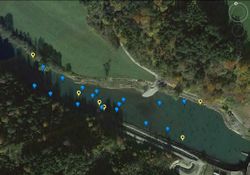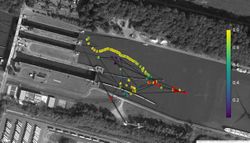Acoustic telemetry
Contents
Quick summary
Developed by:
Date:
Type: Method
Suitable for the following [[::Category:Measures|measures]]:
Introduction
Together with radio and PIT telemetry, acoustic telemetry is a biotelemetry technique that has been used on fish for over 60 years. The principle of acoustic telemetry consists of the communication between an emitting tag (fish) and a receiving device (hydrophone) by means of an acoustic signal to determine the location of the tag (fish). This location can provide useful information about migration, individual behaviour, habitat use, passage efficiency, predation, etc. Acoustic telemetry uses lower radio frequency signals (69-500 kHz) compared to radio telemetry (30-300 MHz), which both have advantages and disadvantages. A major drawback of acoustic compared to radio telemetry used to be the poor reading range in turbulent water systems. Recent developments countered this drawback by using higher frequency signals. Nowadays, also more challenging environments like noisy, shallow and reflective water systems are suitable for acoustic telemetry. This evolution also allows positioning many tagged animals with sub-meter accuracy at the same time. Another unique advantage of acoustic telemetry is its capability to be used in salt and deep water. These features make this technique suitable to conduct fish behaviour studies that are able to address multiple research questions, even for diadromous fish species. Besides a single registration of a fish (1D or presence/ absence), more and more research is done to gather fish tracks in 2D or even 3D at specific sites like migration obstacles, fish passes and hydropower stations (Figure 3). The principle of this precise positioning of fish is based on the difference in detection time of a tag that is positioned in between at least 3 receiving hydrophones. Depending on the producer of the tags and hydrophones, the acoustics work at different kHz ranges. When the producer is VEMCO, then the 2D/3D positioning system is called VPS and this works at either 69 kHz or 180 kHz. Initially, this VPS (Vemco Positioning System) was mainly used in big lakes using 69 kHz tags, but recently small-scale accurate fish tracking is possible using a higher 180 kHz frequency. The choice for one or the other frequency depends on the system studied and the study objectives. Typically, the VPS array is equipped with reference and synchronisation tags to monitor system performance and to correct for clock drift between different submerged hydrophones. Figure 1 and 2 show a VPS array conducted at the Fithydro case study of the river Iller (Altusried, Germany) and another one in the Albert Canal (Ham, Belgium).
Application
The most comprehensive use of acoustic fish telemetry has been done on the large scale 1D migration research. In this setup hydrophones are spread along a lake, a river or a canal and fish are detected when passing these hydrophones. Numerous examples of fish migration studies in large rivers and lakes around the world have been published so far. The advantages of this research technique are found in its good performance in deep and salt water and its large detection range in such situations. Many of these migration studies were conducted on diadromous fish species like eel and salmonids. The typical study design consists of 69 kHz hydrophones and tags with a diameter between 7 and 13 mm. The hydrophones can be moored close to the river banks if the detection range of the tags covers the whole width of the river. In lake or estuary systems, hydrophones can be attached to buoys. This range depends on the tag output power (136-162 dB) and the environmental conditions (noise). Tags are custom-made and programmed to fit the research demands. The determining factors for the setup of a 1D acoustic system are the fish species of interest, its environment and the specific research questions. When studying smaller species or juvenile fish, tag size will limit the battery life. Big rivers with strong currents will require more hydrophones and/or tags with a higher output (so a shorter battery life). When spatial and temporal changes of a certain migration are expected, tags could be programmed in different steps in which the duration, the power output and the signal delay can be changed. During or after the study period, hydrophones have to be lifted for data download by means of Bluetooth connection to a PC. Hydrophones at 69 kHz can operate for more than one year before the battery has to be changed. A single hydrophone can store 1.6 million detections. These unique detections are the result of a so called ‘PPM’ signal (Pulse Position Modulation), which is a ping train of 8 consecutive pings. The separation between each of these individual pings results in a unique ID. The recently developed tags and hydrophones that work on 180 kHz can emit and detect HR (High Residency) coded signals beside PPM coded signals. An HR coded signal is emitted as one ping and does not exist of consecutive ping trains. Hence, the emission time of the code is reduced much and one signal is emitted in less than one second. Consequently, the chance of collision of codes of multiple tagged fish that are within the same detection zone of a hydrophone is reduced. Next, the delay between two consecutive code emissions can be reduced as well, down to one second, allowing more frequent fish positioning (more fish positions per time unit). High frequency tags are smaller compared to the 69 kHz tags (smallest tag diameter is 4 mm). A network of receivers can be used to conduct research on several species at a large scale (Figure 3 and 4).
Other information
More information about range size and species with links to research papers can be found here: https://www.nmt.us/versatile-vie/ There are other types of tags with similar characteristics and/or applications. For example: VI Alpha tags (https://www.nmt.us/vi-alpha/), Anchor tags (https://www.hallprint.com/), piercing tags (https://nationalband.com/fish-tags/).

